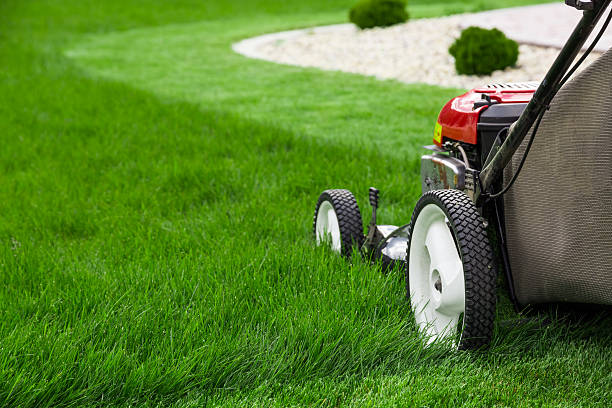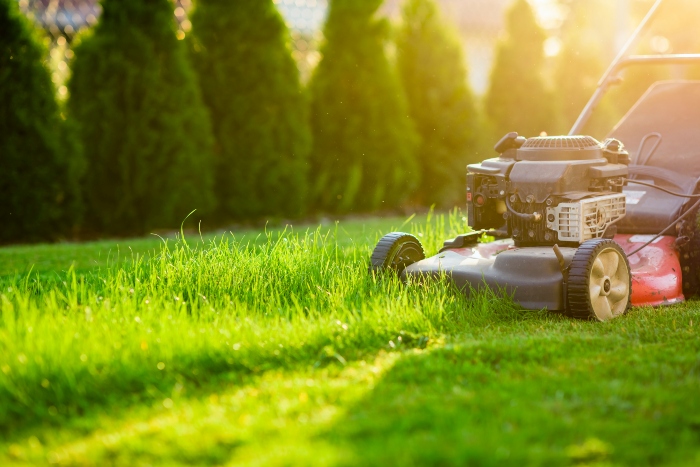When you can enjoy your lawn again, you naturally want it to look nice and green. Important steps in lawn maintenance are: scarifying, sowing, spreading lime, fertilizing and mowing. Check out the five most important steps for maintaining your lawn below.
Maintaining your lawn
What your turf stands up to is determined by the condition of the turf. For example, a recently sown lawn needs a lot of water, while a damaged lawn requires proper repair work. Follow the step-by-step plan below for a beautiful lawn and do not forget to water in dry weather. The grass should not dry out, especially for the first time. To get a full and green lawn and keep it is therefore important to spray.

Don’t have a nice pitch yet, but will one become? Then view our page about laying a lawn.
1. Dethatch the lawn
Grassroots wants to breathe and grow, and they need fresh air for that. The growth of these roots is often stunted because the soil under a lawn does not contain enough sand to keep the soil breathable. By dethatching your lawn, it can then breathe again and the (rain) water returns to the roots.
Scarifying removes a hard layer of moss or vegetable waste from your lawn. Especially after the winter months, your lawn is often full of moss. You do this ‘raking lose’ with a scarifier or scarifier rake. This way your lawn can recover well and the soil remains in top condition.
When to scarify?
As scarifying is an intensive treatment, it is better not to perform it more than once a year. Spring and autumn are the most suitable periods for this.
Heavy job, heavy tools
Do you have a very large lawn? Intratuin also has (electric) scarifiers that do the work for you. Petrol-powered machines are also available for the really large lawns.
2. Sow the lawn
Now that you have removed moss from the lawn, bare patches may appear. Not such a nice sight, but don’t be alarmed: with some new grass seed it will be a beautiful full mat again in a few weeks. Preferably use the same variety of grass seed as when laying. Sow carefully and moisten these areas continuously until well after germination of the grass seeds. After a few months you can apply a slow-acting lawn fertilizer.
Do you want to know more about how to sow a lawn with grass seed? Our blog about creating a lawn explains how to do this.
3. Sprinkle lime
Beautiful lawns have one thing in common: the right acidity. This improves the absorption of nutrients and keeps the soil in top condition, so that the grass grows optimally. Raising a soil pH that is too low can be done by sprinkling lime on your lawn.
When to sprinkle lime?
Often liming once a year is sufficient, this is usually done in the spring. In the case of highly acidic soil it is smart to sprinkle with lime in both spring and autumn. Lime is immediately absorbed, so you can sprinkle all year round without the risk of the grains being washed away by the rain or burning in the sun.
How much lime you should sprinkle depends on the current acidity of your soil. You can measure this with a pH soil test. After spreading lime, beneficial micro-organisms immediately activate the soil life and you get a deep green and moss-free lawn.
Fertilize the lawn
When mowing your lawn, important nutrients disappear from the grass. You have to make up for this shortage yourself by fertilizing. We distinguish two types of fertilizer: organic and mineral (artificial) fertilizers.
Organic fertilizer not only improves growth, but is also friendly to the structure of the soil. It is also very suitable for fertilizing a lawn on poor sandy soil. We also sell fertilizers that consist of a combination of mineral and organic substances. These do work faster, but for a shorter time and the good properties of organic fertilizers are partly lost.
When to fertilize?
Organic fertilizing is done in early spring; the first time spreading in March / April. The temperature then rises, which makes the grass want to rise again. As mentioned, the nutrients from the manure are released slowly, and that is exactly the intention. The second feeding time is in June / July, and will help the lawn through the summer.
With a natural fertilizer it is okay if it is dry or very hot outside; a rain shower or the moisture in the ground allows the lawn to recover quickly. The third feeding time is in September / October, this is also the last time in the year that fertilization is required and also helps against moss formation in winter.

5. Mow the lawn and trim edges
For a nice dense lawn you have to mow regularly. In combination with watering and fertilizing your lawn, mowing also works well against the formation of weeds in the grass. You can mow the lawn every week from May to October. Preferably when it is dry, so that cut chips do not remain on your lawn as piles.
Avoid always pushing the blades of grass in the same direction by mowing in different directions each time. The stems of grass blades usually need to be shortened by about one-half to two-thirds, to about two inches. When it is very hot, for example in the middle of summer, it is better to leave the grass a little longer. In this way it can better cope with the drought.
In addition to mowing, you will also have to keep the edges of the lawn for a nice tight lawn. You do this by cutting off the grass and cutting the edges of your lawn. With an edging trimmer you can provide a beautiful separation of your lawn from the paving or other parts of your garden every six months. You can trim the edges after every mowing with grass shears. We have grass shears that you operate by hand, but also work on a battery. An (electric) grass trimmer cuts the blades of grass with automatic precision.
Easy to perform in one day
Steps 1 to 4 are very easy to perform on one beautiful spring day. Liming and fertilizing on the same day is only possible with 100% organic products. Otherwise there must be at least 2 weeks in between, because lime and fertilizer can work against each other.

